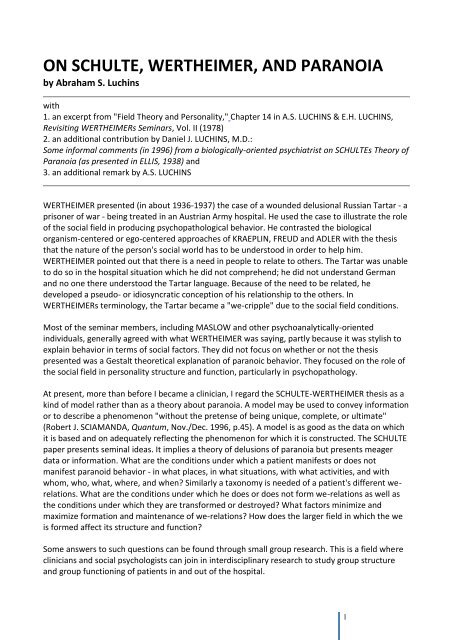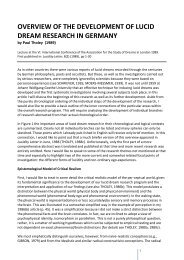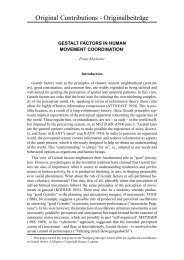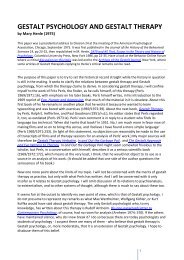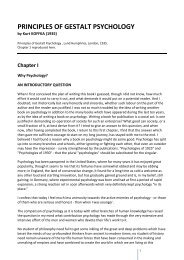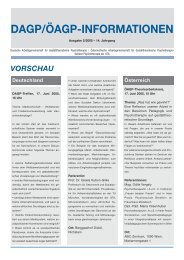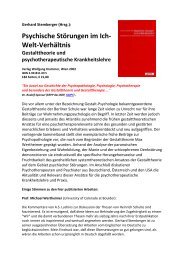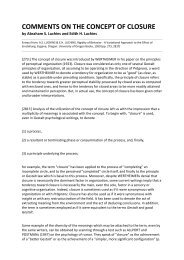on schulte, wertheimer, and paranoia - Society for Gestalt Theory ...
on schulte, wertheimer, and paranoia - Society for Gestalt Theory ...
on schulte, wertheimer, and paranoia - Society for Gestalt Theory ...
You also want an ePaper? Increase the reach of your titles
YUMPU automatically turns print PDFs into web optimized ePapers that Google loves.
Normal people also have hallucinati<strong>on</strong>s, delusi<strong>on</strong>s, or mispercepti<strong>on</strong>s <strong>and</strong> misc<strong>on</strong>cepti<strong>on</strong>s. Whatare the differences <strong>and</strong> similarities between their experiences <strong>and</strong> the corresp<strong>on</strong>ding experiencesof patients? And how do the ways in which individuals correct themselves compare <strong>for</strong> normalpeople <strong>and</strong> psychotic patients? Preliminary studies were undertaken with normal subjects, based<strong>on</strong> discussi<strong>on</strong>s in WERTHEIMERs seminars (e.g., WERTHEIMERs Seminars Revisited: Problems ofPercepti<strong>on</strong>, Volume V, 1974, pp. 261 ff). Preliminary studies of patients' delusi<strong>on</strong>s <strong>and</strong>hallucinati<strong>on</strong>s were made when I worked <strong>for</strong> the U.S. Army <strong>and</strong> Veterans Administrati<strong>on</strong>. Methodswere also developed to help patients correct their delusi<strong>on</strong>s <strong>and</strong> hallucinati<strong>on</strong>s. The methods <strong>and</strong>results are described in papers <strong>on</strong> group psychotherapy, e.g., the role of the social field inrestructuring patients' percepti<strong>on</strong>s. Some of the methods are related to the psychosocial biologicalapproach used by Adolf MEYER (1913) <strong>for</strong> treating <strong>and</strong> rehabilitating patients to entertainalternative hypotheses as well as to the methods used by Oskar DIETHELM (1936/1955) tointroduce habits of doubt about false interpretati<strong>on</strong>s. Perhaps because of the disrupti<strong>on</strong> ofcommunicati<strong>on</strong>s in World War I, MEYERs paper may not have been read by SCHULTE. Themethods are also related to Adhemar GELBs <strong>and</strong> Kurt GOLDSTEINs treatment <strong>and</strong> rehabilitati<strong>on</strong> ofbrain-injured soldiers of World War I. It is of interest to compare the methods with those of moraltreatment in American asylums in the nineteenth-century.In a general sense, the methods are similar to those described by WERTHEIMER <strong>for</strong> productivethinking, problem solving, teaching <strong>and</strong> learning. They also fit WERTHEIMERs challenge that theduty of the therapist is not merely to diagnose or theorize about the patient but to help him. It is aproblem solving situati<strong>on</strong> <strong>for</strong> both the patient <strong>and</strong> the therapist who, with social support, create alearning envir<strong>on</strong>ment. The idea is change the patient's focus <strong>and</strong> to help him to recenter hisc<strong>on</strong>cepts of his social relati<strong>on</strong>ships, e.g., through role-playing, psychodrama, <strong>and</strong> acti<strong>on</strong> researchin his everyday life. The goal is to help the patient restructure his phenomenal world, to develop aviable world that is compatible with social reality. In my pers<strong>on</strong>al experiences, it is important to beoptimistic about achieving this goal <strong>and</strong> to c<strong>on</strong>vey this optimism to the patient.Footnotes(1) Cf. Heinrich SCHULTE (1924). At the time of WERTHEIMERs seminars, the abridged translati<strong>on</strong> ("An Approach to a<strong>Gestalt</strong> <strong>Theory</strong> of Paranoia," Selecti<strong>on</strong> 31 in Willis D. ELLIS, A Source Book of <strong>Gestalt</strong> Psychology, Harcourt Brace, 1938)had not yet appeared. For a complete translati<strong>on</strong>, see Erwin LEVY, "A <strong>Gestalt</strong> <strong>Theory</strong> of Paranoia," <strong>Gestalt</strong> <strong>Theory</strong>, Vol.8 (4), 1986, pp. 230-255, who refers to the SCHULTE-WERTHEIMER theory. A.S. LUCHINS & E.H. LUCHINS, RevisitingWERTHEIMERs Seminars, Bucknell University Press, Vol. II, 1978. pp. 138-142, presents WERTHEIMERs comments <strong>on</strong>the case of the Tartar <strong>and</strong> <strong>paranoia</strong>.(2) Cf. A.S. LUCHINS, A Functi<strong>on</strong>al Approach to Training in Clinical Psychology via Study of a Mental Hospital, C.C.Thomas, 1959.(3) At times it was difficult to distinguish between delusi<strong>on</strong>s <strong>and</strong> what the psychiatrist Carl WERNICKE in 1906 called"overvalued ideas". Recently Paul R. McHUGH wrote "an overvalued value has three characteristics: (1) it is a selfdominatingbut not idiosyncratic opini<strong>on</strong>, given great importance by (2) internal emoti<strong>on</strong>al feelings over thesignificance, <strong>and</strong> evoking (3) persistent behavior in its service" (The American Scholar, Winter 1997, p.20).(4) Cf. "The Role of the Social Field in Psychotherapy," Journal of C<strong>on</strong>sulting Psychology, 1948, Vol. XII, pp. 417-425 <strong>and</strong>"Restructuring Social Percepti<strong>on</strong>s: A Group Psychotherapy Technique," Journal of C<strong>on</strong>sulting Psychology, 1950, Vol.XIV, pp. 446-451. A recent study at the University of Chicago Pritzker School of Medicine found that patients who werenot demented could correct some of their mispercepti<strong>on</strong>s. The results were similar to ours.(5) Adolf MEYER, "The Treatment of Paranoic <strong>and</strong> Paranoid States," in William A. WHITE <strong>and</strong> Smith E. JELLIFFE, Eds.,The Modern Treatment of Nervous <strong>and</strong> Mental Diseases, Volume I, pp. 614-661, Lea & Febiger, Philadelphia, 1913.2
Oskar DIETHELM, Treatment in Psychiatry, Macmillan, New York, 1936/1955.(6) Albert DEUTSCH, The Mentally Ill in America: A History of Their Care <strong>and</strong> Treatment from Col<strong>on</strong>ial Times,Doubleday, Doran, Garden City, New York, 1937, Columbia University Press, New York, 1949. Nancy TOMES, AGenerous C<strong>on</strong>fidence: Thomas Story Kirkbride <strong>and</strong> the Art of Asylum Keeping, 1840-1883, Cambridge University Press,New York, 1983. A.S. LUCHINS, "Moral Treatment in Asylums <strong>and</strong> General Hospitals in 19th-Century America," TheJournal of Psychology,123(6), 585-607, 1989; "The Cult of Curability <strong>and</strong> the Doctrine of Perfectibility: Social C<strong>on</strong>text ofthe Nineteenth-Century American Asylum Movement," History of Psychiatry, iii, 203-220, 1992.(7) For example, Kurt GOLDSTEIN, The Organism; A Holistic Approach to Biology Derived from Pathological Data inMan. American Book Co., New York, 1939; Z<strong>on</strong>e Books, New York, 1995.(8) Productive Thinking, Harper, 1945/1959, <strong>and</strong> "The Syllogism <strong>and</strong> Productive Thinking," 1925, Selecti<strong>on</strong> 23 in ELLIS,1938.From "Field <strong>Theory</strong> <strong>and</strong> Pers<strong>on</strong>ality,"Chapter 14 in A.S. LUCHINS & E.H. LUCHINS,Revisiting WERTHEIMERs Seminars, Vol. II, 1978, pp. 138-139WERTHEIMER presented an illustrati<strong>on</strong> from psychopathology to show the effects of the socialfield <strong>on</strong> a pers<strong>on</strong> (cf. SCHULTE, 1924). A wounded Russian Tartar was captured al<strong>on</strong>e <strong>and</strong> treatedin an Austrian Army Hospital where he developed delusi<strong>on</strong>s of being persecuted. He also heardvoices, showed extreme anxiety <strong>and</strong> made suicidal attempts. This was diagnosed as an acuteparanoid episode. WERTHEIMER asked, What is the cause of such behavior? According toKRAEPLIN, you must study his pedigree, look <strong>for</strong> paranoid tendencies in his history <strong>and</strong> look <strong>for</strong>gl<strong>and</strong>ular disturbances. One tries to show that <strong>paranoia</strong> is due to innate dispositi<strong>on</strong>. According topsychoanalysis it has a homosexual basis; there<strong>for</strong>e, you study the historical development of thelibido to find that it is due to unc<strong>on</strong>scious homosexuality. You may find an unresolved Oedipuscomplex, he loves his father, is not loved by girls, he desires men but finds men cold, he thinks thatthey hate him, <strong>and</strong> there<strong>for</strong>e he gets delusi<strong>on</strong>s. In resp<strong>on</strong>se to a questi<strong>on</strong> WERTHEIMER said thataccording to ADLER an inferiority complex causes <strong>paranoia</strong> <strong>and</strong> then asked, What do all theseexplanati<strong>on</strong>s have in comm<strong>on</strong>? The situati<strong>on</strong> in which the man finds himself <strong>and</strong> what happens tohim in it are ignored. Some<strong>on</strong>e said that these theorists do look at the situati<strong>on</strong>, they look at it interms of their theories <strong>for</strong> the cues that indicate the operati<strong>on</strong> of the factors that are basic in theirtheories. WERTHEIMER remarked, There is a lack of realizati<strong>on</strong> of what actually happens to theparticular individual in the present. You get a different picture if you c<strong>on</strong>sider that the Tartar wascaptured al<strong>on</strong>e <strong>and</strong> was placed in a strange hospital. He was brought into a field of which he is tobe a part, a patient; he is a member of a group of people in a room all of whom talk to each otherbut not to him. In this field there are <strong>for</strong>ces that make him feel that they are against him; he isgiven medicine <strong>and</strong> an operati<strong>on</strong> <strong>and</strong> is <strong>for</strong>ced to cooperate. He does not speak German, no <strong>on</strong>eknew his Tartar language. He knows nothing of occidental hospitals; he cannot underst<strong>and</strong> thefield that acts <strong>on</strong> him but he cannot escape. He is in a hospital of the enemy. What are they tryingto do to me, it hurts, I cannot resist, I must do as they tell me. This led to excitement, causedtensi<strong>on</strong>s. He wants some sort of relati<strong>on</strong> to the field, he feels in need of communicati<strong>on</strong> butcannot get it. He finally relates himself to it as the group versus him. A situati<strong>on</strong> arose in which hewanted to become part of a We but he was a We-cripple. The focus of all his thinking is directed<strong>on</strong> this particular difficulty. He dashes himself against the obstacle, he is excited, bewildered,panicky. He feels something is wr<strong>on</strong>g; he feels as some<strong>on</strong>e apart from the others, as outside of thegroup. This feeling creates isolati<strong>on</strong>, a feeling of I versus others; they versus me. His ego becomes3
important; it is an ego not related to any<strong>on</strong>e. WERTHEIMER asked, How does a man in such asituati<strong>on</strong> behave? He might take it as a theater scene, but he hears the others talk <strong>and</strong> he isexcluded. He wants to know what they are talking about; he makes a hypothesis; they are talkingabout me, against me. Everything now is interpreted in light of this c<strong>on</strong>cepti<strong>on</strong> of the situati<strong>on</strong>;the disequilibrium is now changed into a equilibrium. They are talking about me, the doctor wantsto pois<strong>on</strong> me. The situati<strong>on</strong> is now clarified; things have meaning; he has a relati<strong>on</strong>ship to the field<strong>and</strong> has a mode of c<strong>on</strong>duct in it; he fights to save himself; he tries to escape by suicide.Some<strong>on</strong>e interrupted to ask what happened to the Tartar. WERTHEIMER said, they got a man whounderstood the Tartar's dialect; he talked to him <strong>and</strong> he was cured.... WERTHEIMER remarked thatsome say that <strong>paranoia</strong> is never cured.Other Comments:Daniel J. LUCHINS, M.D.Some in<strong>for</strong>mal comments (in 1996) from a biologically-orientedpsychiatrist <strong>on</strong> SCHULTEs <strong>Theory</strong> of Paranoia (as presented inELLIS, 1938):1. Let me start by saying that the paper appears to be c<strong>on</strong>centrating <strong>on</strong> abstracti<strong>on</strong>. People needto feel part of a group (we-ness). When this is interrupted they may develop <strong>paranoia</strong> (ideas ofreference, persecuti<strong>on</strong> or gr<strong>and</strong>iose illusi<strong>on</strong>s) to reestablish some we-ness. It may be useful tothink of such behavior as related to a need to bel<strong>on</strong>g to a group -- but that doesn't mean that the"need to bel<strong>on</strong>g to a group" exists outside of our use of this as a c<strong>on</strong>struct.2. The theory is not biologically based. It makes no reference to the brain or to evoluti<strong>on</strong>.Currently most biological theories of psychopathology will make a reference to at least <strong>on</strong>e ofthese. For example, you can argue that people develop misidentificati<strong>on</strong> syndrome because ofdamage to systems relating to facial recogniti<strong>on</strong>. Bowlby's work <strong>on</strong> depressi<strong>on</strong> as related tomaternal deprivati<strong>on</strong> experiments in m<strong>on</strong>keys <strong>and</strong> the biological importance of maternal-childb<strong>on</strong>ding might be a sec<strong>on</strong>d example.Paranoia may have to do with evoluti<strong>on</strong>. Phobias may have an evoluti<strong>on</strong>ary basis. The capacity tofear; the fear of falling; agrophobia - no place to hide - evoluti<strong>on</strong> has given us the fear of being cutoff from the tribe, cut off from com<strong>for</strong>t; the social fear of strangers - a new face not in your tribemay be a threat. People have a need to be c<strong>on</strong>nected in a tribe, a family, a group, a "we."My own theory of <strong>paranoia</strong> would lean towards the evoluti<strong>on</strong>ary explanati<strong>on</strong>. "If you d<strong>on</strong>'t knowwhat's going <strong>on</strong>, it's safer to think that it involves you than to ignore it." You are walking in awilderness 6 milli<strong>on</strong> years ago - a branch breaks - do you think it might mean that there is a tigerplanning to jump <strong>on</strong> you or do you think, "Could it just be the wind?" It probably is to youradvantage to have the first view, the "fall back" positi<strong>on</strong>, <strong>and</strong> turn to the alternative view whenyou know more about what is going <strong>on</strong>.When people d<strong>on</strong>'t know or trust what's going <strong>on</strong>, <strong>paranoia</strong> may occur. They probably fall back toa more familiar situati<strong>on</strong>. For example, when the computer jams, you may think it means, "O.K..Watch out. You better watch out. It probably has to do with something you did."4
3. There is some support <strong>for</strong> this view. In experiments with hallucinogenics, students start to show<strong>paranoia</strong> when they stop knowing what is really going <strong>on</strong>, i.e., this is an experiment, that is an MD,I'm being paid to do this, etc. The same explanati<strong>on</strong> probably relates to the increased <strong>paranoia</strong>seen in people who are deaf, new immigrants, after cataract surgery when visual images areinterfered with, etc., etc. - all situati<strong>on</strong>s in which there is a breakdown in the usual ability to "knowwhat is going <strong>on</strong>."4. Obviously, <strong>on</strong>e could say that in all the situati<strong>on</strong>s discussed in 3, there is a reducti<strong>on</strong> in "weness,"but I d<strong>on</strong>'t believe that is adds anything, <strong>and</strong> is rather too narrow. There is a breakdown inknowing what's going <strong>on</strong>. For example, I was walking past a parked car <strong>on</strong>e day <strong>and</strong> the windshieldwipers moved. I thought "Did I bang something, is there a light beam that I passed through?" Iwalked back to inspect it <strong>and</strong> they moved again. Then I realized the car had been turned off withthe windshield wipers <strong>on</strong> automatic. But in the presence of a new situati<strong>on</strong> that I didn'tunderst<strong>and</strong>, my first impulse was to be self-referential.Am<strong>on</strong>g biologically-oriented psychiatrists c<strong>on</strong>cerned with <strong>paranoia</strong> or schizophrenia, currently theemphasis is <strong>on</strong> neurotransmitters <strong>and</strong> neurochemistry. They may speculate about why patients dothis or that acti<strong>on</strong>, but they are usually more c<strong>on</strong>cerned with why patients have obsessi<strong>on</strong>s thanwith the particular obsessi<strong>on</strong>s. Neurotransmissi<strong>on</strong> drugs <strong>and</strong> their effects, e.g., <strong>on</strong> dopamine, d<strong>on</strong>ot have to do with treatment of specific problems or acti<strong>on</strong>s. Why do patients repeatedly washtheir h<strong>and</strong>s, check the door or the stove, or have ideas of reference of persecuti<strong>on</strong>? Morediscussi<strong>on</strong> is needed of the c<strong>on</strong>tent as well as of the functi<strong>on</strong> <strong>and</strong> purpose of <strong>paranoia</strong> in specificcases.**Remark added by A.S. Luchins:With the drug approach, is there no place <strong>for</strong> psychotherapy to help the patient c<strong>on</strong>struct a livableworld <strong>and</strong> take care of his everyday problems in the social field? My experiences indicate thatdrugs do not obviate psychosocial interventi<strong>on</strong> which, moreover, can have the added dividend ofhelping the patient to comply with his drug regime. It is noteworthy that the biologically-orientedpsychiatrist whose views were cited above believes that there should be more c<strong>on</strong>cern with thespecific c<strong>on</strong>tent of the <strong>paranoia</strong>.Copyright © 1997 , A.S. Luchins. D.J. Luchins. All Rights Reserved.These papers were prepared as a c<strong>on</strong>tributi<strong>on</strong> to the discussi<strong>on</strong> in the psychotherapy secti<strong>on</strong> ofthe GTA about the SCHULTE theses <strong>on</strong> <strong>paranoia</strong>. They were translated into German by GerhardStemberger; this German versi<strong>on</strong> was published in ÖAGP-In<strong>for</strong>mati<strong>on</strong>en, 6 (1/1997), pp II-VII.5


